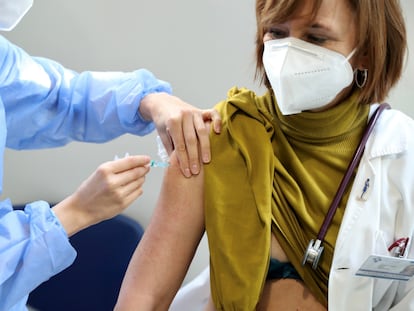Spain sets record for new coronavirus cases for second day in a row
A total of 44,357 infections were added to the Health Ministry’s latest report, a level only comparable to weekend figures in the second wave

For the second day in a row, the number of new coronavirus cases reported by the central Health Ministry has set a record high for the pandemic so far. A total of 44,357 infections were added to the ministry’s latest report, a level that was seen during the second wave in the autumn on a Monday – when the figures account for Friday, Saturday and Sunday. There have now been 2,456,675 official cases of coronavirus recorded by the health authorities since the health crisis began last year.
Speaking at a press conference to present the figures last night, Fernando Simón, the director of the Health Ministry’s Coordination Center for Health Alerts (CCAES), admitted that the data was bad, but he insisted that this third wave may now be reaching its peak.
The pressure on hospitals is now greater than it was during the second wave of the pandemic
The government’s chief epidemiologist pointed to the total of reported cases over the last seven days, which came in at 244,708 in Thursday’s report – a 31% rise on the same indicator on January 14. It’s a significant increase but inferior to the 51% rise seen between the last two Mondays, or the 93% that it went up between January 7 and 14.
With these new infections, the 14-day cumulative number of coronavirus cases per 100,000 inhabitants is now near the 800 mark, coming in at 795.65 in Thursday’s report. Simón insisted that the indicator would take longer to reflect the flattening of the curve given that it takes in the last two weeks, a time period when infections have been rising sharply. The fall in rhythm is seen, however, if the seven-day figure is compared: on Friday it went up 64%, while yesterday it rose 52%.
Simón also discussed the new, more contagious strain of the coronavirus that was first detected in the United Kingdom. He predicted that it could come to be the dominant variation of the virus “by mid-March” should it progress as it has in the UK, accounting for 40 to 50% of cases, compared to the 5% it accounts for currently. The CCAES chief pointed out that it was first detected in the UK at the end of September, but it wasn’t until mid-December when it was identified as causing 40% of cases in that country compared to 4% three months prior.
Broken down by region, the data from Thursday’s report brings little good news. The incidence has risen in all territories. One week ago there was just one region with a 14-day cumulative number of coronavirus cases per 100,000 inhabitants above 1,000: Extremadura. Now there are six: Castilla-La Mancha, Castilla y León, Valencia, Extremadura, Murcia and La Rioja.
The worsening situation is prompting the regions – who are in charge of handling the pandemic in their territories – to implement more restrictions. In the Basque Country, for example, the city of Bilbao has been subjected to a perimetral lockdown. The result of this, as Health Minister Salvador Illa told EL PAÍS earlier this week in an interview, is that the regions are gradually moving toward the kind of full lockdown currently in place in other European countries, with the closure of hostelry establishments, a restriction on opening hours for businesses, a curfew and limits to the number of people who can meet in social settings.
Simón said the new, more contagious strain of the coronavirus first detected in the UK could become the dominant variant in Spain “by mid-March”
Simón has once again called for patience for these measures to take effect, while the Health Ministry is insisting that there is no need for an earlier curfew nor for home confinements, as some regions have been requesting. Such measures would require a renegotiation and new vote in the Congress of Deputies on the state of alarm that is currently in place, and which is not due to expire until May 8.
The pressure on hospitals, meanwhile, is now greater than it was during the second wave of the pandemic. One in every five beds in the country is currently taken by a Covid-19 patient, a record level since the first wave. This is forcing surgeries to be canceled or delayed. Valencia and Castilla-La Mancha, with 39% and 32% occupation, respectively, are under the greatest pressure. The growth in demand is not suggesting there will be any relief for hospitals in the short term, with occupation rising 4.61% over the previous 24 hours according to Thursday’s report. On the previous Thursday, that figure was 3.42%.
It’s a similar story in the country’s intensive care units (ICUs), where 36.78% of beds are occupied by Covid patients, another new record in this wave – a week ago the figure was 28.46%. Only six territories are below 20%, but several are very close to that level: Asturias (19.57%), Canary Islands (13.32%), Cantabria (19.67%), Ceuta (17.65%), Galicia (18.57%) and Navarre (16.26%).
These rising infection levels eventually translate into high numbers of fatalities. Thursday’s report added 404 new victims to the overall death toll, compared to 464 on Wednesday and 404 on Tuesday. The result is a total of 1,9662 victims over the last seven days, which is close to the levels seen at the end of November, at the peak of the second wave. There have now been 55,041 official coronavirus deaths in Spain since the health crisis began.
English version by Simon Hunter.
Tu suscripción se está usando en otro dispositivo
¿Quieres añadir otro usuario a tu suscripción?
Si continúas leyendo en este dispositivo, no se podrá leer en el otro.
FlechaTu suscripción se está usando en otro dispositivo y solo puedes acceder a EL PAÍS desde un dispositivo a la vez.
Si quieres compartir tu cuenta, cambia tu suscripción a la modalidad Premium, así podrás añadir otro usuario. Cada uno accederá con su propia cuenta de email, lo que os permitirá personalizar vuestra experiencia en EL PAÍS.
¿Tienes una suscripción de empresa? Accede aquí para contratar más cuentas.
En el caso de no saber quién está usando tu cuenta, te recomendamos cambiar tu contraseña aquí.
Si decides continuar compartiendo tu cuenta, este mensaje se mostrará en tu dispositivo y en el de la otra persona que está usando tu cuenta de forma indefinida, afectando a tu experiencia de lectura. Puedes consultar aquí los términos y condiciones de la suscripción digital.
More information
Últimas noticias
The brief rise and retreat of Generation Z in Mexico
A floating school teaches children how to save Lake Atitlán
Pablo Escobar’s hippos: A serious environmental problem, 40 years on
From Andorra to Gibraltar, a black market for Ozempic exploits its success: ‘They’re the most sought-after products in the world’
Most viewed
- Why we lost the habit of sleeping in two segments and how that changed our sense of time
- Charles Dubouloz, mountaineering star, retires at 36 with a farewell tour inspired by Walter Bonatti
- Venezuela faces its most tense Christmas yet
- Trump’s obsession with putting his name on everything is unprecedented in the United States
- CBS in crisis after pulling a report on Trump’s deportations to El Salvador (which later leaked online)










































